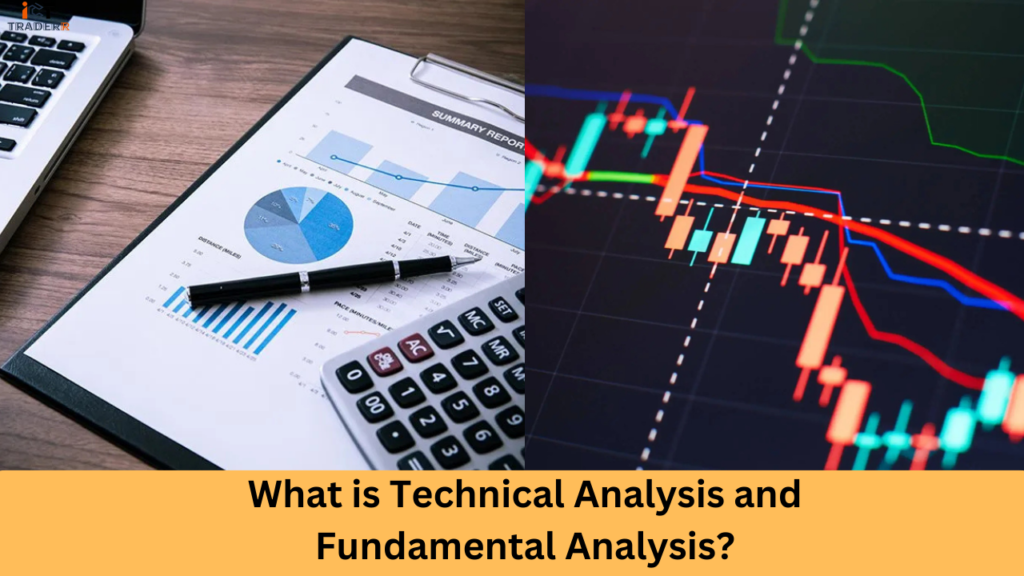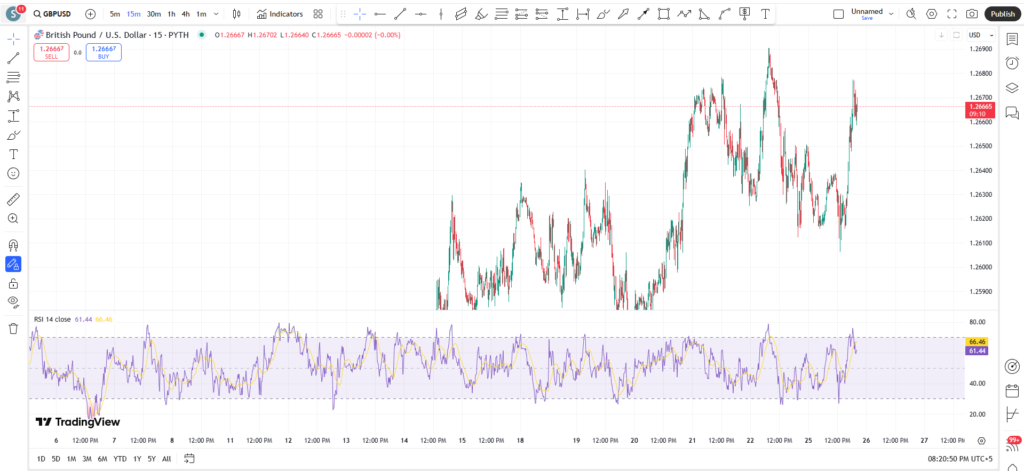Technical analysis and fundamental analysis are the two most important techniques used in determining and predicting price movements in financial markets in the world of trading and investing. Price trends, patterns, and indicators are measured by technical analysis, while fundamental analysis considers a company’s financial position, the state of the economy, and intrinsic value to examine whether it is a worthwhile investment. An investor in securities will have to understand both techniques before making any investment decision.
In this guide, we will look at how both methods work, their pros and cons, and how their integration can contribute to forming an awesome strategy for investing. So let us start.

What is Technical Analysis?
Technical analysis is a means of studying the forex market by looking at the price charts and trading volumes. Rather than worrying about a company’s finances or what kind of great set it has in the industry, technical analysts are concerned only with the price action in patterns and trends. The underlying rationale is based on the belief that history tends to repeat itself thus, by studying past price-action behaviors, one could purport to predict the path of future prices.
Key Ideas Behind Technical Analysis
Technical analysis focuses on price movement, trends, and patterns, thus predicting future market behavior. The critical concepts influencing each method are elaborated on below.
Price: Technical analysts believe that all potential influences on prices as news, earnings, and market sentiments, are represented in the price itself.
Trends: Prices tend to move in trends, either up or down, or sideways, and these trends usually exist until a change occurs.
Patterns Repeat: Market participants exhibit recurring behaviors that yield patterns that can be used to predict future prices.
Tools Used in Technical Analysis
Build your basics stronger with our understanding market structure guide
Technical analysts use tools like:
Charts: Line charts, bar charts, and candlestick charts to visualize price movements.
Indicators: Moving averages, RSI (Relative Strength Index), MACD (Moving Average Convergence Divergence), and Fibonacci retracements to confirm trends and forecast potential reversals.

Who Uses Technical Analysis?
This method is liked among short-term traders, like day and swing traders who make rapid decisions depending on price movements. It also finds common applications in markets such as forex, commodities, and cryptocurrencies, characterized by rapid shifts in prices.
What is Fundamental Analysis?
Fundamental analysis is all about perceiving real value in a company or asset. Fundamental analysts study a company’s financial statements, the position of its industry, and the potential growth of that industry to decide whether or not an investment is good. They are trying to identify stocks that they deem to be undervalued (cheaper than it ought to be) or overvalued (more expensive than it ought to be).
Key Ideas Behind Fundamental Analysis
Fundamental analysts concentrate on understanding a company’s financial condition, the economic environment, and intrinsic worth assessment in assessing a business’s long-term prospective utility. The critical concepts influencing each method are elaborated on below.
Intrinsic Value: This method concentrates on estimating the true value of a company based on its fundamentals.
Long-Term Focus: Appropriate for the long-term investor rather, who will intend to hold their investment for years.
Deep Research: Analysts consider everything-from financial results through trends, over to economic conditions.
What Do Fundamental Analysts Look At?
A fundamentalist analyst examines key metrics to assess the overall financial health of a company. Financial statements, relevant ratios, and macroeconomic factors are analyzed to understand a company’s stability, growth potential, and long-term investment viability.
Important Metrics and Considerations
Financial Statements: Profit and loss accounts, balance sheets, and cash flow statements show the profitability, debt, and inflow of cash into a company.
Ratios: P/E ratio, Debt-Equity Ratio, and Return on Equity are some ratios that help to assess its financial health.
Macro Factors: Interest rates, GDP growth, and inflation are some issues that can affect the performance of a company.
When is Fundamental Analysis Used?
Long-term investors such as value or growth investors frequently use fundamental analysis to buy and hold securities over long periods. Companies in less volatile industries with predictable earnings are ideal candidates for fundamental analysis.
Pros and Cons of Technical and Fundamental Analysis
Technical Analysis Pros:
- Great for short-term trading and finding entry/exit points.
- Works in all markets stocks, forex, crypto, etc.
- Helps traders spot trends and take advantage of market momentum.
Technical Analysis Cons:
- Relies on past data, which may not always predict the future.
- Can be subjective different traders might see different patterns.
- Doesn’t account for sudden news or changes in fundamentals.
Fundamental Analysis Pros:
- Helps you understand a company’s true value and growth potential.
- Ideal for long-term investment decisions.
- Consider qualitative elements like administration quality and industry patterns.
Fundamental Analysis Cons:
- Takes a lot of time and requires deep research.
- May not help with short-term price movements or market sentiment.
- Less effective for highly volatile markets or quick trades.
Key Differences Between Technical and Fundamental Analysis
| Aspect | Technical Analysis | Fundamental Analysis |
| Time Horizon | Short-term | Long-term |
| Data Used | Price and volume data | Financial statements, economic data |
| Focus | Market psychology and trends | Intrinsic value and financial health |
| Tools | Charts, indicators, patterns | Ratios, financial metrics, qualitative analysis |
When to Use Technical vs. Fundamental Analysis
Use Technical Analysis If:
You are a short-term trader (day or swing trading).
Price patterns are what lead you to entry and exit points.
You are geared toward trading high-volatility markets, either forex or crypto.
Use Fundamental Analysis If:
You trade for the long term looking for undervalued stocks.
You want to assess a company’s financial health and growth potential.
You invest in modest industries with predictable earnings.
The use of both methods in combination is a thing of the present. For example, the investors use it to do modest analysis of the stock via fundamental tools and for the final decision, they utilize technical sources.
Combining Fundamental and Technical Analysis Works for Smarter Investing
Many investors consider combining fundamental and technical analyses to be the most reliable approach in deciding investments. The rationale is rather simple: use the strengths of one approach to cover the weaknesses of the other. This blends the two approaches for a better extent of market view, allowing for a smarter investment decision.
To get started using this methodology, one would use fundamental analysis to ascertain the real value of an asset. In other words, such factors as the financial statements, market trends, and other significant influences on a company’s performance are considered. For example, you can look at a company’s profits, debts, and growth potential to figure out whether it is a good investment.
Once the promising asset is targeted, you study its technical analysis for the buy or sell entry timing. This involves price charts, price pattern analysis, and indicators such as moving averages or the Relative Strength Index (RSI). With this, technical analysis demonstrates the market trend and the best timing for adaptation/exiting from a position.
Combining the two methodologies gives a far broader understanding of the market. Fundamental analysis evaluates the risk and value of an investment, whereas technical analysis helps perfect the more precise timing for entering and exiting trades, making the blended approach appropriate for short-term trading and long-term investing.
Real-World Examples
Some real-world examples that traders use for technical and fundamental analysis. Which is explained below:
Technical Analysis Example:
During the 2021 Bullock Run, traders used tools like RSI and moving averages to figure out overbought conditions and expected price drops.
Fundamental Analysis Example:
Warren Buffet’s investment in Coca-Cola is an excellent case of fundamental analysis in which he considered the company’s well-known brand, stable earnings, and competitive advantages.
Combined Approach Example:
A trader would use fundamental analysis to spot a promising technology stock and then use technical analysis to pick the best time to purchase by looking at all possible chart patterns.
Conclusion
Though technical and fundamental analysis can be applied mutually, each serves a distinct objective. Technical analysis is better for short-term trading and identifying trends with technical analysis on the other hand, long-term investing is facilitated, and finally understanding the true quality of a business- but this depends largely on your goals, level of patience, and degree of risk tolerance. If you learn to practice and most importantly apply forms according to the market situation, it logically guides you to better decisions.
Frequently Asked Questions
Can I use both technical and fundamental analysis?
Yes, many professional investors use a hybrid approach.
Which method is better for beginners?
Fundamental analysis is often more straightforward for beginners to understand.
How long does fundamental analysis take?
Comprehensive fundamental analysis can take several weeks.
Are these methods guaranteed to predict market movements?
No investment strategy guarantees success. These are tools to inform decisions, not predict with certainty.
Do professional traders use these methods?
Yes, both methods are widely used by professional investors and traders.


